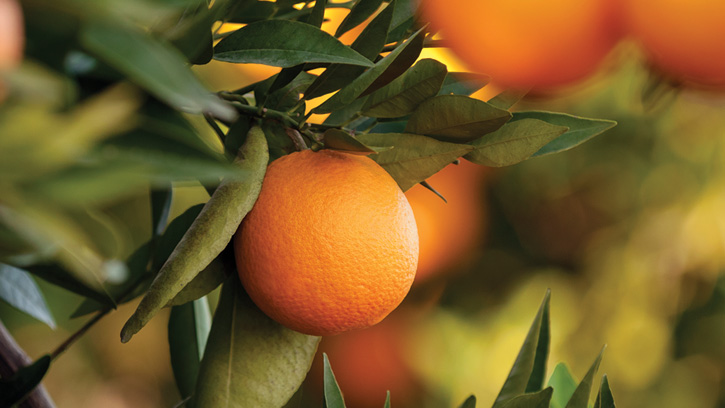Making Citrus Delicious and Disease Resistant
Science Forward | RESEARCH
There’s a reason Florida and oranges are so inextricably linked—the state grows 80% of the United States’ juicing oranges.
But a serious problem appeared in South Florida in 2005: citrus greening disease. Officially called Huanglongbing (HLB), it’s now infecting citrus trees around the world. HLB is caused by bacteria, it’s spread by a tiny insect, and there’s no cure. Florida’s orange production is now at about 40% of what it was in 2000.
“Ever since the disease has appeared, researchers have been working really hard, but it’s very complicated because it’s a complex [interaction] between bacteria and insect vector,” says Anne Plotto, research plant physiologist at the U.S. Horticultural Research Laboratory in Fort Pierce, Fla., part of the U.S. Department of Agriculture’s (USDA) Agricultural Research Service. Oranges from HLB-infected trees are small and bitter tasting.
But researchers realized that there were some hybrid trees that seemed resistant to HLB. Back in the 1940s, USDA plant breeders in Florida developed crosses between Citrus and Poncirus trifoliata (commonly called hardy orange) as a cold-tolerant citrus. Recent research has found that these trees can withstand the HLB disease.
However, the resulting fruit, says Plotto, is “like a ping-pong ball full of seeds with no juice, and even if you could extract the juice, you don’t want to drink it because it’s acrid.” So Plotto and her colleagues set out to discover if there were Poncirus trifoliata hybrids that could produce juice that was tasty enough to drink and thus would have potential to be used as commercial varieties.
A Taste for Citrus
The researchers used fruit harvested in the fall and winter from six hybrids and two regular mandarins for control. The fruit was washed, sanitized, and carefully juiced by hand. (Commercially processed orange juice has a different taste because some of the peel gets included during juicing.)
The juice was served at 18°C to tasting panels composed of 11 trained panelists, most of whom had previous experience with sensory assessments of citrus. They devoted five hour-long tasting sessions to evaluating the juice. The researchers also chemically analyzed the juice samples before the tasting panels were held to enable them to link the fruit’s chemicals with the sensory results.
Tasting panel members described a wide range of tastes and aftertastes—from pleasant and sweet to very sour and burning. The researchers found that four of the hybrids were good enough to consume, with predominant floral, mandarin, orange, sweet, sour, and fruity flavors.
“The finding is that, yes, we can have hybrids with Poncirus in the background that can be tolerant to HLB and still give good quality,” says Plotto.
The accompanying chemical analysis revealed some interesting findings. For some of the hybrids, floral flavors were linked to bitter limonoids, but those bitter limonoids don’t always result in bitter tastes.
Plotto is currently supervising a postdoctoral student who is working to identify exactly which flavonoids in citrus are interacting and creating the bitter tastes. She is hopeful that this research will help citrus breeders, and that by using genetic analysis, they will be able to select seedlings that are both resistant to HLB and yield tasty fruit.
The complete citrus genome was only recently published, says Plotto, helping researchers understand a very complex genus.
“Citrus is so complicated,” she says. “It’s more complicated than any other plant. Even though I have a plant background in education and horticulture, I am still puzzled by everything in citrus breeding.”


